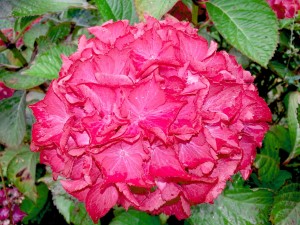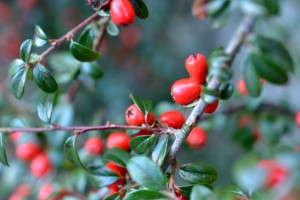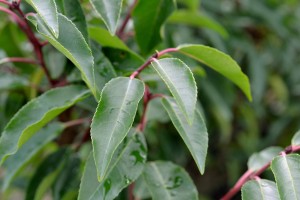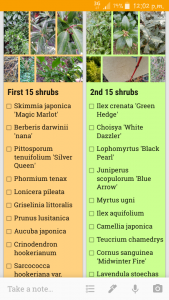
Hydrangea macrophylla ‘Selma’
Over six weeks have passed since I wrote the article about following my curiosity, joined a dozen students in Kildalton Agricultural & Horticulture College and began studying the Level 6 Advanced Certificate in Horticulture. This third level course is packed with information aimed at increasing our knowledge. From Consumer and Data Protection and Wildlife and Habitat Acts to social enterprise ideas, environmental science, biodiversity audits and ecology, tree planting and pruning as well as shrub identification and remembering botanical Latin names; there are heaps to take in and the world is growing larger as a result.
Horticulture is so much more than simply gardening and pulling a few weeds. It’s about nature, food and food sovereignty, sports surfaces, landscaping and creativity. It’s about an appreciation of the planet, the climate, and weather, beauty, and other-worldliness; horticulture is about life and living things, it’s above positive mental health, companionship and connection, it’s dazzlingly gratifying!Ultimately, however, horticulture is about the plants. Recognizing and understanding plants and remembering their botanical Latin names is a necessary requirement of any of the higher level modules and remembering them all can fill students with dread. Botanical Latin became the universal language of plants (and animals) over 250 years ago and it’s still used today to help people have conversations around the world.All students have techniques to help them learn, here’s nine ways I’ve come across to help people remember and spell the botanical Latin names of flowers, trees, herbs, vegetables, and shrubs.
No. 1: Break the names down into smaller words

Cotoneaster conspicuus ‘Decorus’
Many botanical Latin names can be broken down into smaller words that have associations. They might not have the exact spellings, but might be a soundalike.
A couple of examples include: ‘Cotton Easter’ for Cotoneaster or ‘Plait Annoy Dee’s’ for Acer Platanoides.
No. 2: Conjure up images/tell stories
This is the technique I find the most helpful. Coupled with breaking the words into bite sizes as above, dreaming up stories around the words helps me to remember them.
An example here is Crataegus leveagata ‘Paul Scarlet’. The word ‘crusty’ pops into my mind when I hear Crataegus, while Levaegata leaves me thinking about a Harry Potter spell. Whenever I look at the pink flowered Hawthorn tree I imagine myself extravagantly waving a crusty, knobbly wand and chanting a spell.
No. 3: Abbreviate words

Prunus lusitanica
This is Mr. G’s favored technique. He breaks the words into short abbreviations:
Hebe pinguifolia ‘Sutherlandii’ becomes Heb-ping-suth and Prunus lusitanica becomes Pru-lus-ica.
No. 4: Write the names down
Using a notebook dedicated to writing out the botanical Latin names is a technique used by many students and one that reminds me of the pages of lines I had to write in school when I was caught chewing gum. This is the only way I can learn how to spell some of the longer or trickier plant names like Griselinia littoralis or Aesculus hippocastanum.
No. 5: Make phone notes or use a revision app

Google Keep App
I’ve yet to try any revision apps but I find the Google Keep app an invaluable help on my mobile phone. This app stores shareable notes and images in the cloud and I’ve found it helpful to save all the plant names I’m learning in there, along with their respective images. Whenever there’s an opportunity to look at the plant names – waiting in queues, just before bed, waiting for the kettle to boil, the names are there in my pocket.
No. 6: Repeat the words out loud
Combine this with all the other methods and you’re onto a winner. If I can’t pronounce the word out loud, I’ll always struggle to spell or remember it.
If you’re ever close to a horticulture college and you notice students talking to themselves, this is likely what they’re up to.
No. 7: Visualise where the plant is
Have you ever played a group memory game where you have to repeat a sentence said by the person next to you and add to it until the last person has to remember all the sentences? I use this method to help people remember each other’s names at the beginning of workshops. It works for plants too. Visualizing the route you walked as you came across each plant, remembering the name and adding to the list as you continue the mental walk, can really help to embed the plants, their images, and names into the mind.
No. 8: Understand the language
One of the students showed me a beautifully bound RHS book he’d bought called Latin for Gardeners which gives some history and origins of the Latin (or Greek) plant names. For example, angustifolia means narrow-leaved, spinosa means spiny, and ochroleuca means cream. This will help you identify the plants once you’ve learned their name.
No. 9: Look up what the words mean

Hypericum inodorum ‘Magical Red’
Last but I’m sure not least, I googled a few words I was struggling to remember and came up with some surprises. For instance, ‘Glanleam’ (Luma apiculata ‘Glanleam Gold’) is a Bed and Breakfast on Valencia Island and Marlot as in Skimmia Japonica ‘Magic Marlot’ has the opposite meaning to ‘Harlot’. I’ll let you look that one up yourself…
We’ve learned the botanical Latin of fifty plants in the past six weeks. Over the next ten weeks, we’ll be weaving those into assignments, practicing our pruning techniques on the plants, or discussing them in class. We’ll be adding to that list as the leaves begin to appear and we start our leaf identification of deciduous trees.
If you’re learning the botanical Latin names for fun at home, perhaps limit yourself to whatever is manageable. Unless you’re using the names regularly they’re easy to forget, so better to learn a few at a time and remember them all.
Have you any other tips that might help learners to remember the names? What works for you?
Source: Greenside Up – How to Learn Botanical Latin Plant Names






